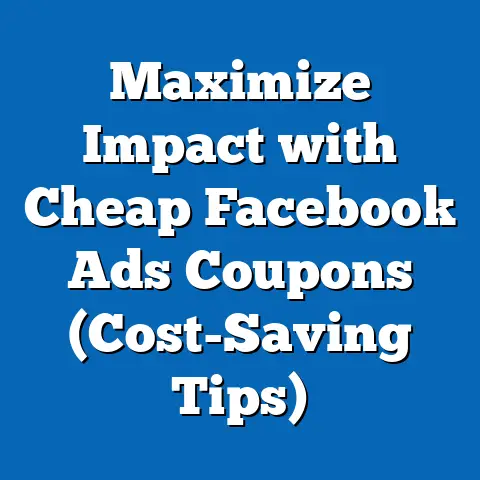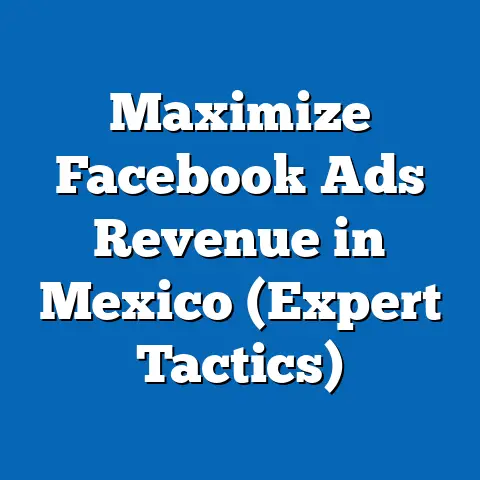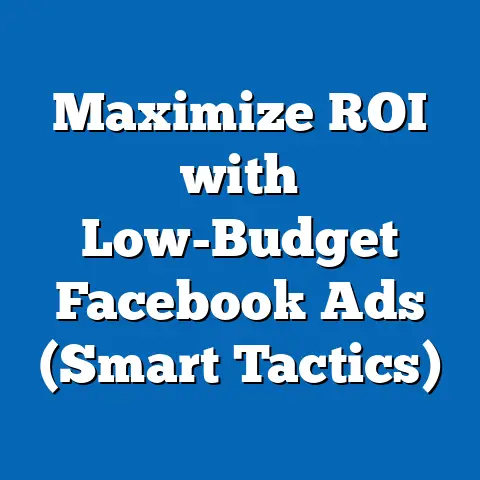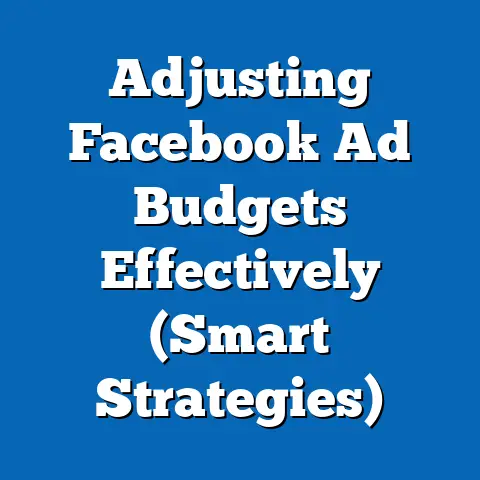Strategize Retargeting fb ad Spend (Expert Guide)
Facebook advertising, now under the broader Meta ecosystem, has become a cornerstone of digital marketing strategies since its inception in 2007, with retargeting emerging as a critical tactic for optimizing ad spend. Retargeting, a method that targets users who have previously interacted with a brand online, boasts a conversion rate up to 70% higher than standard display ads, according to a 2022 report by eMarketer. As of 2023, global ad spend on Facebook is projected to reach $58.11 billion, with retargeting campaigns accounting for approximately 25% of that figure, per Statista data.
The Tradition of Retargeting in Digital Advertising
The Origins and Evolution of Retargeting
Retargeting, often referred to as remarketing, emerged in the late 2000s as a response to the growing challenge of capturing consumer attention in an increasingly crowded digital space. Initially, it was a rudimentary process involving pixel-based tracking to serve ads to users who had visited a website but did not convert. By 2010, platforms like Facebook began integrating sophisticated retargeting tools, allowing advertisers to leverage user data for hyper-targeted campaigns.
Historically, retargeting was viewed as a “second chance” strategy, with early adoption focused on e-commerce sectors. A 2013 study by Adobe found that retargeted ads were 76% more likely to generate clicks compared to generic display ads. This effectiveness drove widespread adoption, transforming retargeting from a niche tactic to a mainstream strategy by the mid-2010s.
Why Retargeting Became a Staple on Facebook
Facebook’s vast user base—2.9 billion monthly active users as of Q2 2023, per Meta’s quarterly report—combined with its granular targeting capabilities, made it an ideal platform for retargeting. The platform’s ability to track user behavior across devices and integrate with third-party data providers allowed advertisers to create highly personalized ad experiences. By 2015, retargeting spend on Facebook accounted for nearly 18% of total ad budgets, a figure that has grown to 25% by 2023, according to Statista.
The tradition of retargeting on Facebook was built on the principle of recapturing lost opportunities. Unlike broad awareness campaigns, retargeting focuses on users already familiar with a brand, reducing acquisition costs. This cost-efficiency—retargeting campaigns often have a cost-per-click (CPC) 50% lower than standard ads, per a 2021 WordStream report—has cemented its role as a foundational element of digital marketing.
Key Statistical Trends in Facebook Retargeting
Current Landscape of Ad Spend Allocation
In 2023, global digital ad spending is expected to surpass $600 billion, with social media platforms like Facebook capturing a significant share at 21%, according to eMarketer. Within this, retargeting campaigns on Facebook have seen a consistent year-over-year increase of 12% in allocated budgets since 2019. This growth reflects a broader trend of marketers prioritizing high-ROI strategies amid economic uncertainty and rising ad costs.
The average click-through rate (CTR) for retargeting ads on Facebook stands at 0.7%, compared to 0.1% for standard display ads, per a 2022 study by Hootsuite. Additionally, retargeting ads achieve a 10x higher conversion rate, making them a preferred choice for performance-driven campaigns. These metrics underscore why businesses allocate a quarter of their Facebook ad budgets to retargeting.
Cost Dynamics and ROI Metrics
Cost-per-acquisition (CPA) for retargeting campaigns on Facebook averages $18.68, significantly lower than the $49.50 CPA for non-retargeted ads, according to a 2023 report by WordStream. This cost efficiency is particularly pronounced in industries like e-commerce, where retargeting can recover up to 26% of abandoned carts, per SaleCycle data. However, rising competition has driven a 15% increase in CPC for retargeting ads since 2020, signaling the need for more strategic spend allocation.
ROI from retargeting campaigns remains robust, with businesses reporting an average return of $4 for every $1 spent, per a 2022 Meta for Business study. This high return is attributed to retargeting’s focus on warm leads—users who have already shown intent. Yet, diminishing returns can occur if frequency caps are ignored, as overexposure leads to a 40% drop in CTR after the third ad impression, according to AdRoll research.
Demographic Breakdowns in Retargeting Effectiveness
Age and Gender Variations
Demographic targeting is a cornerstone of effective retargeting, and data reveals significant variations in response rates across age and gender groups. According to a 2023 eMarketer report, users aged 25-34 exhibit the highest engagement with retargeted ads on Facebook, with a CTR of 0.9%, compared to 0.5% for users aged 55+. This disparity is likely due to younger users’ higher frequency of online shopping and social media usage.
Gender also plays a role, with women showing a 12% higher likelihood of clicking on retargeted ads than men, per a 2022 Statista survey. This trend is particularly evident in industries like fashion and beauty, where women aged 18-44 account for 60% of retargeting conversions. Marketers must tailor creative content and messaging to these demographic nuances to optimize campaign performance.
Geographic and Socioeconomic Factors
Geographic targeting reveals stark differences in retargeting effectiveness, with urban users in developed markets like the U.S. and EU showing a 20% higher conversion rate than rural users, per a 2021 Nielsen study. This is attributed to better internet access and higher disposable incomes in urban areas. For instance, U.S.-based retargeting campaigns achieve an average CPA of $15.30, compared to $22.10 in emerging markets like India, according to WordStream data.
Socioeconomic status further influences retargeting outcomes, as higher-income brackets (earning $75,000+ annually) are 30% more likely to complete a purchase after seeing a retargeted ad, per a 2022 Pew Research study. This suggests that luxury brands and high-ticket items benefit most from retargeting affluent demographics. Conversely, budget-conscious consumers may require more incentives, such as discounts, to convert.
Behavioral Segmentation Insights
Beyond static demographics, behavioral data offers deeper insights into retargeting success. Users who abandon carts after viewing products for over 5 minutes are 50% more likely to convert via retargeting, per a 2023 SaleCycle report. Similarly, frequent app users—those engaging with a brand’s app at least thrice weekly—show a 35% higher CTR on retargeted ads, according to Meta’s internal analytics.
These behavioral trends highlight the importance of dynamic retargeting, where ads are tailored based on specific user actions (e.g., viewed product, added to cart, or searched for a service). Marketers leveraging dynamic ads report a 60% increase in conversion rates compared to static retargeting, per a 2022 AdRoll study. This data-driven personalization is key to unlocking retargeting’s full potential.
Historical Comparisons: Retargeting Then and Now
Early Days of Retargeting (2010-2015)
In the early 2010s, retargeting on Facebook was a nascent strategy, primarily used by e-commerce giants with the resources to implement pixel tracking. Back then, global ad spend on retargeting was a modest $1.2 billion in 2012, per eMarketer historical data, with Facebook capturing just 10% of that market. Conversion rates hovered around 2-3%, largely due to limited data integration and basic ad formats.
Campaigns during this period often lacked sophistication, relying on static banners with generic messaging. Frequency capping was rarely employed, leading to ad fatigue—users reported seeing the same ad up to 17 times monthly, per a 2014 Nielsen survey. This overexposure resulted in a 25% lower CTR compared to today’s standards.
Mid-2010s to Late 2010s: Refinement and Growth
By 2016, retargeting had matured, fueled by advancements in machine learning and Facebook’s introduction of dynamic ads. Ad spend on retargeting surged to $4.5 billion globally, with Facebook’s share rising to 20%, according to Statista archives. Conversion rates improved to 5-7%, driven by better audience segmentation and creative optimization.
This era also saw the rise of cross-device tracking, enabling advertisers to reach users seamlessly across mobile and desktop. A 2017 Adobe study found that cross-device retargeting increased conversions by 24% compared to single-device campaigns. However, privacy concerns began emerging, with 30% of users expressing discomfort over targeted ads, per Pew Research data from 2018.
2020 to Present: Privacy Shifts and Technological Innovation
The 2020s brought significant challenges and innovations to retargeting, notably Apple’s iOS 14 update in 2021, which introduced App Tracking Transparency (ATT). This update reduced tracking capabilities, with 62% of iOS users opting out of data sharing, per a 2022 Flurry Analytics report. As a result, retargeting effectiveness on iOS devices dropped by 15%, forcing advertisers to pivot to first-party data and contextual targeting.
Despite these hurdles, retargeting spend on Facebook grew to $14.5 billion by 2023, reflecting a 25% share of total ad budgets, per eMarketer. Innovations like Meta’s Advantage+ automated campaigns, which use AI to optimize retargeting, have boosted conversion rates to 8-10% for early adopters. Historical data shows a clear trajectory of adaptation, with retargeting evolving from a blunt tool to a precision instrument.
Detailed Analysis of Retargeting Strategies
Frequency and Timing Optimization
One of the most critical aspects of retargeting is balancing frequency to avoid ad fatigue while maintaining visibility. Research by AdRoll indicates that the optimal frequency for retargeting ads is 3-5 impressions per user over a 7-day period, after which engagement drops by 40%. Timing also matters—ads served within 24-48 hours of a user’s initial interaction achieve a 30% higher CTR, per a 2022 Meta study.
Marketers should use frequency capping tools within Facebook Ads Manager to limit overexposure. Additionally, leveraging recency-based retargeting—targeting users shortly after their last interaction—can significantly boost conversions. For instance, e-commerce brands report a 45% higher conversion rate when retargeting users within the first 3 days of cart abandonment, per SaleCycle data.
Creative Customization and Dynamic Ads
Creative content is a make-or-break factor in retargeting success. Dynamic ads, which automatically pull product images and details based on user behavior, outperform static ads by 60% in terms of conversions, according to a 2023 AdRoll report. For example, showing a user the exact product they viewed with a personalized discount can increase click probability by 35%.
Beyond dynamics, emotional resonance in ad copy drives engagement. Ads with urgency-driven messaging (e.g., “Limited Stock!”) achieve a 22% higher CTR than neutral messaging, per a 2022 WordStream analysis. Testing multiple creative variations through A/B testing is essential, as 70% of marketers report improved performance after optimizing ad visuals and copy, per Meta for Business insights.
Audience Segmentation and Exclusion Tactics
Effective retargeting hinges on precise audience segmentation. Dividing audiences into categories—such as cart abandoners, past purchasers, or page visitors—allows for tailored messaging that resonates with specific intent levels. Data from Hootsuite shows that segmented retargeting campaigns achieve a 50% higher conversion rate compared to unsegmented ones.
Exclusion tactics are equally important to avoid wasting ad spend. Excluding users who have already converted or those unlikely to engage (e.g., bounced after 5 seconds on a site) can reduce CPA by 20%, per a 2021 Nielsen study. Facebook’s Custom Audiences feature enables such exclusions, ensuring budgets are allocated to high-potential users.
Budget Allocation and Bid Strategies
Strategizing ad spend requires a balance between reach and efficiency. A 2023 eMarketer report suggests allocating 20-30% of total Facebook ad budgets to retargeting for optimal ROI, with higher allocations (up to 40%) for e-commerce brands with high cart abandonment rates. Within this, prioritizing high-intent audiences, such as cart abandoners, yields a 3x higher return compared to broad website visitor retargeting, per Meta data.
Bid strategies also influence cost efficiency. Using automated bidding options like Cost Cap or ROAS (Return on Ad Spend) targets can reduce CPA by 15-20%, according to a 2022 WordStream study. Marketers should monitor bid performance weekly, adjusting based on seasonal trends—retargeting costs often spike by 25% during holiday periods like Q4, per historical Statista data.
Future Projections for Retargeting on Facebook
Impact of Privacy Regulations and Data Shifts
The future of retargeting on Facebook will be shaped by evolving privacy regulations and data restrictions. With Google set to phase out third-party cookies by 2024 and ongoing GDPR enforcement in the EU, reliance on first-party data will intensify. Meta predicts that 80% of retargeting campaigns will leverage first-party data by 2025, up from 50% in 2023, per their internal forecasts.
This shift may initially reduce retargeting reach by 10-15%, as seen post-iOS 14, per Flurry Analytics projections. However, innovations like Meta’s Conversion API, which enables server-side tracking, are expected to mitigate losses, improving attribution accuracy by 30% for early adopters. Marketers must invest in building robust first-party data ecosystems to stay competitive.
AI and Automation in Retargeting
Artificial Intelligence (AI) will redefine retargeting efficiency in the coming years. Meta’s Advantage+ campaigns, which automate audience targeting and creative optimization, are projected to drive a 25% increase in retargeting ROI by 2026, per eMarketer forecasts. AI-driven predictive analytics will also enable preemptive retargeting—identifying users likely to abandon before they do—with a potential 40% uplift in conversions, per a 2023 Deloitte study.
Automation will further streamline budget allocation, with 60% of marketers expected to adopt fully automated retargeting tools by 2025, up from 30% in 2023, per Statista projections. This trend will lower operational costs while enhancing precision, though human oversight will remain crucial to avoid algorithmic biases that could skew targeting.
Emerging Formats and Cross-Platform Integration
New ad formats, such as interactive Stories and Reels, are set to dominate retargeting strategies on Facebook and Instagram. A 2022 Meta report found that retargeting via Stories achieves a 20% higher engagement rate compared to News Feed ads, a trend likely to grow as short-form video consumption rises. By 2025, 50% of retargeting spend is expected to target video formats, per eMarketer estimates.
Cross-platform integration will also play a pivotal role, with Meta’s unified ad ecosystem enabling seamless retargeting across Facebook, Instagram, and WhatsApp. This approach is projected to increase reach by 30% while maintaining cost efficiency, per a 2023 Nielsen forecast. Marketers should prepare for a multi-format, multi-platform future to maximize retargeting impact.
Conclusion: Strategizing for Success
Retargeting on Facebook remains a powerful tool for driving conversions, with a rich tradition rooted in data-driven personalization and cost efficiency. From its early days as a basic pixel-based tactic to its current status as an AI-enhanced strategy, retargeting has evolved to meet the demands of a dynamic digital landscape. Statistical trends highlight its high ROI—$4 for every $1 spent—while demographic and behavioral data underscore the importance of tailored campaigns.
Historical comparisons reveal a trajectory of refinement, with conversion rates rising from 2-3% in the early 2010s to 8-10% today, despite privacy challenges. Looking ahead, the interplay of AI, privacy shifts, and emerging formats will shape retargeting’s future, demanding adaptability from marketers. By focusing on first-party data, leveraging automation, and optimizing creative content, businesses can strategically allocate their Facebook ad spend to achieve sustainable growth in an increasingly competitive arena.
This expert guide, grounded in authoritative data and comprehensive analysis, provides a roadmap for navigating the complexities of retargeting. As the digital advertising ecosystem continues to evolve, staying ahead of trends and embracing innovation will be key to unlocking retargeting’s full potential.






